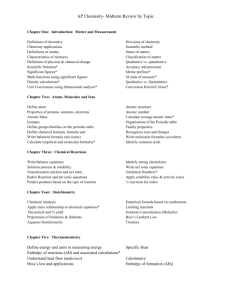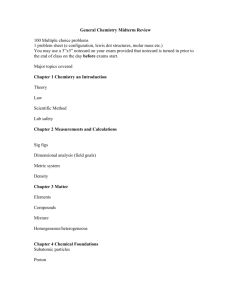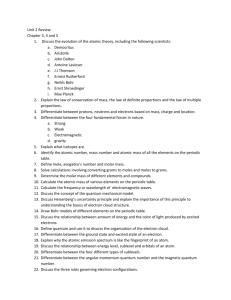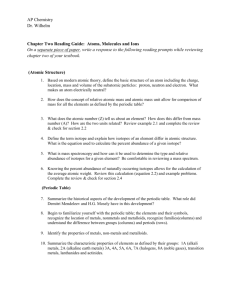CHEMISTRY - SkyView Academy
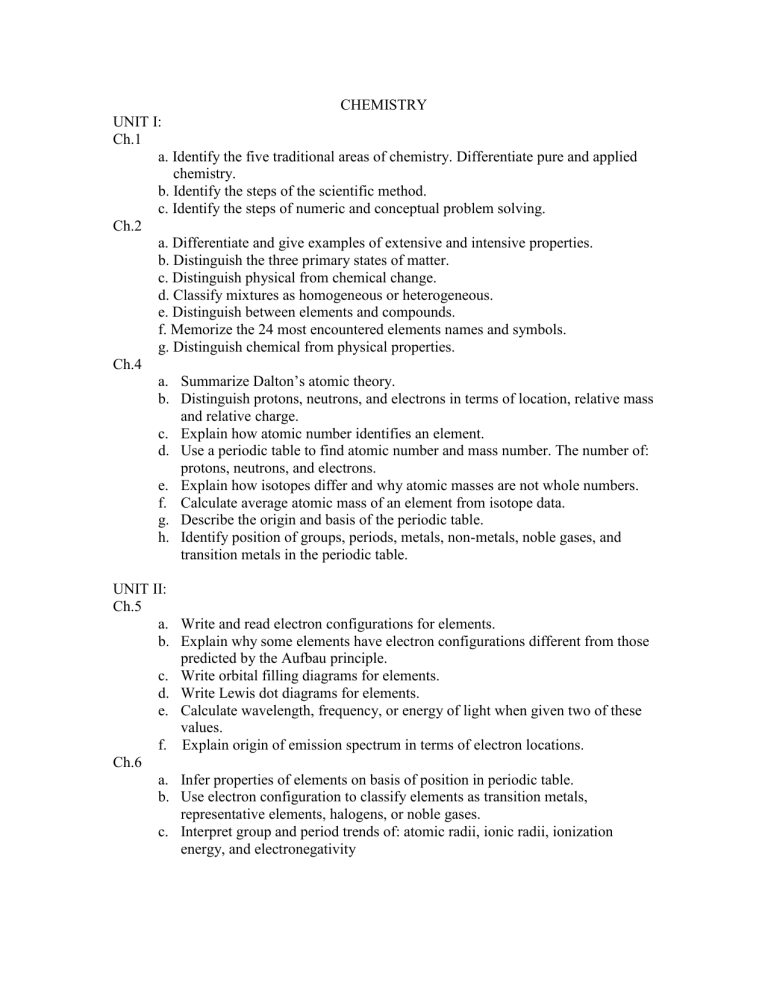
CHEMISTRY
UNIT I:
Ch.1 a. Identify the five traditional areas of chemistry. Differentiate pure and applied
chemistry. b. Identify the steps of the scientific method. c. Identify the steps of numeric and conceptual problem solving.
Ch.2 a. Differentiate and give examples of extensive and intensive properties. b. Distinguish the three primary states of matter. c. Distinguish physical from chemical change. d. Classify mixtures as homogeneous or heterogeneous. e. Distinguish between elements and compounds. f. Memorize the 24 most encountered elements names and symbols. g. Distinguish chemical from physical properties.
Ch.4 a.
Summarize Dalton’s atomic theory. b.
Distinguish protons, neutrons, and electrons in terms of location, relative mass and relative charge. c.
Explain how atomic number identifies an element. d.
Use a periodic table to find atomic number and mass number. The number of: protons, neutrons, and electrons. e.
Explain how isotopes differ and why atomic masses are not whole numbers. f.
Calculate average atomic mass of an element from isotope data. g.
Describe the origin and basis of the periodic table. h.
Identify position of groups, periods, metals, non-metals, noble gases, and transition metals in the periodic table.
UNIT II:
Ch.5 a.
Write and read electron configurations for elements. b.
Explain why some elements have electron configurations different from those predicted by the Aufbau principle. c.
Write orbital filling diagrams for elements. d.
Write Lewis dot diagrams for elements. e.
Calculate wavelength, frequency, or energy of light when given two of these values. f. Explain origin of emission spectrum in terms of electron locations.
Ch.6 a.
Infer properties of elements on basis of position in periodic table. b.
Use electron configuration to classify elements as transition metals, representative elements, halogens, or noble gases. c.
Interpret group and period trends of: atomic radii, ionic radii, ionization
energy, and electronegativity
UNIT III:
Ch.7 a.
Distinguish between ionic, metallic, and molecular bonds. b.
Define cation and anion and relate them to metals, non-metals, and e
-
transfer. c.
Determine basic ion charge from elements location in periodic table. d.
Define polyatomic ion. e.
Use the periodic table to infer the number of valence electrons and draw dot diagrams for atoms. f.
Describe the formation of cations and anions. g.
List characteristics of ionic bond. Explain conductivity of ionic compounds. h.
Describe the basis for the metallic bond and the characteristics of metals.
Ch. 8 a. List properties of molecules. b. Use electron dot structures to show single, double, and triple bonds. c. Describe coordinate covalent bonds and resonance structures. d. Use VSEPR theory to predict and explain shapes of molecules. e. Use electronegativity to classify bonds as: ionic, covalent, or polar covalent.
UNIT IV:
Ch. 9
Ch. 22 a. Memorize name, formula, and charge for six common polyatomic ions. b. Write names and formulas for binary and ternary ionic compounds. c. Write names and formulas for binary molecular compounds. d. Write names and formulas for binary and ternary acids and bases a.
Hydrocarbons: naming, structures, isomerism.
UNIT V:
Ch.3 a.
Distinguish between quantitative and qualitative measurements. b.
Convert between scientific and standard notation. c.
Distinguish among accuracy, precision, and relative error of a measurement. d.
Calculate percent error. Identify number of significant digits in a measurement and utilize them in rounding results of calculations. e.
List and use SI units and prefixes. f.
Distinguish between mass and weight. g.
Calculate the density of a sample of matter from experimental data. h.
Convert between Celsius and Kelvin temperature scales. i. Construct and apply conversion factors to problems. j. Convert complex units, using dimensional analysis.
Ch.10 a.
Describe how Avogadro’s number is related to a mole of any substance. b.
Calculate the mass of a mole of any substance. c.
Convert amongst mass, volume, and number of particles. d. Calculate percent composition from chemical formula or experimental data.
e. Derive empirical formula and molecular formula from experimental data.
CHEMISTRY 2 nd
semester
UNIT VI:
Ch.11
Write and read chemical equations using appropriate symbols.
Write balanced chemical equations when given names or formulas for reactants and products.
Identify reactions as combustion, synthesis, decomposition, single replacement, double replacement, neutralization, or oxidation-reduction.
Predict products of reactions when given reactants and reaction type.
Write and balance net ionic reactions.
Use solubility rules to predict precipitate in double replacement reactions.
UNITVII:
Ch. 12
Interpret balanced chemical equations.
Calculate stoichiometric quantities using balanced chemical equations, moles, mass, particles, and volume.
Identify the limiting reagent in a chemical reaction and calculate maximum amount of products produced.
Calculate theoretical yield and percentage yield.
UNIT VIII:
Ch.13
Describe the motion of gas particles according to the kinetic theory.
Interpret gas pressure in terms of kinetic theory.
Describe the nature of a liquid in terms of kinetic theory and particle interactions.
Differentiate evaporation and boiling of a liquid in terms of kinetic theory.
Describe the nature of solids in terms of kinetic theory.
Differentiate between crystal lattice and unit cell.
Convert between the pressure units: kPa, atm, and mm Hg.
Convert between the temperature units of Celsius and Kelvin.
UNIT IX:
Ch. 14
Explain the relationship between kinetic energy of gas particles and temperature.
Explain the relationship between amount of gas, volume of container, temperature, and pressure.
Apply the gas laws to problems involving temperature, volume, and pressure of a contained gas.
Calculate partial pressures and relative rates of effusion.
UNIT X:
Ch. 15, 16, 19
Describe hydrogen bonding in water and explain its effect on vapor pressure, boiling point, specific heat capacity, and surface tension.
Explain why ice floats in water.
Differentiate between electrolytes and non-electrolytes.
Use Henry's Law for solubility and pressure.
Describe the solution process and factors affecting it. (16.1)
Solve problems involving concentration expressed in molarity. (16.2)
Solve problems involving preparation of dilute solutions from concentrated solutions of known molarity. (16.2 )
Explain colligative properties on a particle basis. (16.3)
Solve problems involving concentration expressed in molality. (16.4)
Solve problems of boiling point elevation and freezing point depression. (16.4)
Describe acid-base theory. (19.1)
Calculate pH and pOH (19.2)
UNIT XI
Ch. 17
Explain the relationship between energy and heat.
Distinguish between heat capacity and specific heat.
Write and interpret equations showing heat changes for chemical and physical processes.
Calculate heat changes in chemical and physical processes.
Classify and calculate the heat changes that occur during phase changes of melting, freezing, boiling, and condensing.
UNIT XII
Ch. 25
Name and describe natural radiation.
Write and balance nuclear equations.
List some applications and uses for radioactive isotopes.
Compare and contrast nuclear fission and fusion

